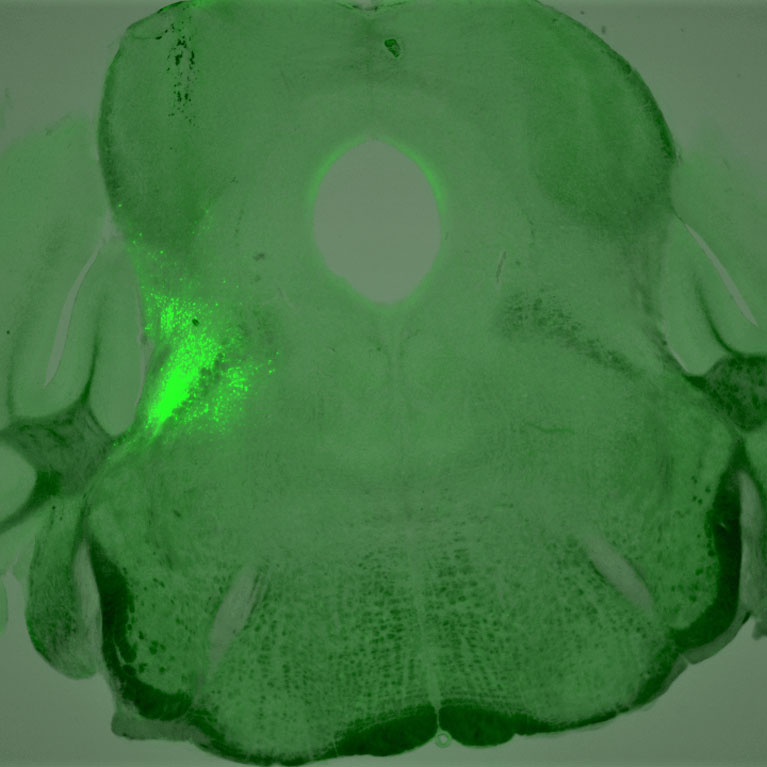Salk Press Releases
Researchers identify neurons involved in overdose deaths
LA JOLLA—It’s long been known that opioid overdose deaths are caused by disrupted breathing, but the actual mechanism by which these drugs suppress respiration was not understood. Now, a new study by Salk scientists has identified a group of neurons in the brainstem that plays a key role in this process.
Guardians of the synapse: scientists identify a new role for nerve-supporting cells
LA JOLLA—Salk researchers have found, for the first time, that a blood-clotting protein can, unexpectedly, degrade nerves—and how nerve-supporting glial cells, including Schwann cells, provide protection. The findings, published March 14, 2019, in the journal PLOS Genetics, show that Schwann cells protect nerves by blocking this blood-clotting protein as well as other potentially destructive enzymes released by muscle cells. The work could have implications for diseases as diverse as amyotrophic lateral sclerosis (ALS), multiple sclerosis, Alzheimer’s disease or schizophrenia.
“Busybody” protein may get on your nerves, but that’s a good thing
LA JOLLA—Sensory neurons regulate how we recognize pain, touch, and the movement and position of our own bodies, but the field of neuroscience is just beginning to unravel this circuitry. Now, new research from the Salk Institute shows how a protein called p75 is critical for pain signaling, which could one day have implications for treating neurological disorders as well as trauma such as spinal cord injury.
Elevating brain protein allays symptoms of Alzheimer’s and improves memory
LA JOLLA—Boosting levels of a specific protein in the brain alleviates hallmark features of Alzheimer’s disease in a mouse model of the disorder, according to new research published online August 25, 2016 in Scientific Reports.
Salk scientists uncover new clues to repairing an injured spinal cord
LA JOLLA—Frogs, dogs, whales, snails can all do it, but humans and primates can’t. Regrow nerves after an injury, that is—while many animals have this ability, humans don’t. But new research from the Salk Institute suggests that a small molecule may be able to convince damaged nerves to grow and effectively rewire circuits. Such a feat could eventually lead to therapies for the thousands of Americans with severe spinal cord injuries and paralysis.
Salk scientist discovers novel mechanism in spinal cord injury
LA JOLLA, CA—More than 11,000 Americans suffer spinal cord injuries each year, and since over a quarter of those injuries are due to falls, the number is likely to rise as the population ages. The reason so many of those injuries are permanently disabling is that the human body lacks the capacity to regenerate nerve fibers. The best our bodies can do is route the surviving tissue around the injury site.
Salk professors awarded chair appointments
LA JOLLA, CA—The Salk Institute is pleased to announce that professors E.J. Chichilnisky, Jan Karlseder, and Kuo-Fen Lee have each been selected as the recipient of an endowed chair to honor their consistent scientific excellence and support their biological research.
At last, a function at the junction-Salk researchers discover that stem cell marker regulates synapse formation
LA JOLLA, CA—Among stem cell biologists there are few better-known proteins than nestin, whose very presence in an immature cell identifies it as a “stem cell,” such as a neural stem cell. As helpful as this is to researchers, until now no one knew which purpose nestin serves in a cell.
Repairing a ‘bad’ reputation?
La Jolla, CA—New research at the Salk Institute for Biological Studies casts the role of a neuronal growth factor receptor—long suspected to facilitate the toxic effects of beta amyloid in Alzheimer’s disease—in a new light, suggesting the molecule actually protects the neuron in the periphery from beta amyloid-induced damage.
A possible mechanistic link between stress and the development of Alzheimer tangles
La Jolla, CA – Subjecting mice to repeated emotional stress, the kind we experience in everyday life, may contribute to the accumulation of neurofibrillary tangles, one of the hallmarks of Alzheimer’s disease, report researchers at the Salk Institute for Biological Studies. While aging is still the greatest risk factor for Alzheimer’s disease, a number of studies have pointed to stress as a contributing factor.
Insulin: in need of some restraint?
La Jolla, CA – Knocking out the gene for a peptide associated with insulin secretion protects mice against the harmful effects of a high-fat diet, report researchers at the Salk Institute for Biological Studies. Their findings, detailed in the Proceedings of the National Academy of Sciences, suggest that urocortin 3, a new peptide recently discovered in the insulin secreting cells of the pancreas, plays a role in the increased production of insulin in response to high caloric intake in animals.
Developing nervous system sculpted by opposing chemical messengers
La Jolla, CA – A newborn baby moves, breathes and cries in part because a network of nerves called motor neurons carry signals from the infant’s brain and spinal cord to muscles throughout its body.
Potential Link Found Between Breast Cancer Drug and Cardiac Failure
La Jolla, CA – A team led by Salk scientists has identified the probable link between the breast cancer drug Herceptin and cardiac failure, one of its common side effects. The results may also explain why a common combination drug regimen including Herceptin is particularly toxic.
Synapse Formation Triggered By Muscle, Salk Scientists Show
La Jolla, CA – Sometimes nerve is all you need. But nerves have needs, too, including the use of synapses – tiny junctions that coordinate communication between nerves and the muscles they control.
Single Gene Deficiency Makes Mice “Neurotic”
La Jolla, CA – Mice are not usually noted for their stalwart natures, but a new Salk Institute study shows that the loss of a single gene can render them especially anxious. The resulting “neurotic” mice approach new situations tentatively and appear to experience stress more acutely than normal mice.










